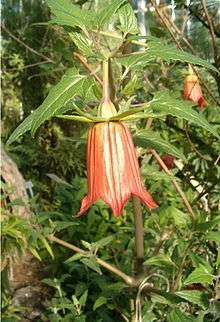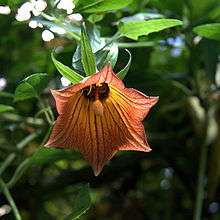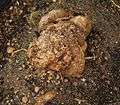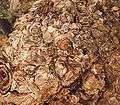Canarina canariensis
| Canarina canariensis | |
|---|---|
 | |
| Canarina canariensis Canary Island Bellflower | |
| Scientific classification | |
| Kingdom: | Plantae |
| (unranked): | Angiosperms |
| (unranked): | Eudicots |
| (unranked): | Asterids |
| Order: | Asterales |
| Family: | Campanulaceae |
| Genus: | Canarina L. |
| Species: | C. canariensis |
| Binomial name | |
| Canarina canariensis L. Vatke | |
Canarina canariensis (L.) Vatke. is a glabrous, glaucous, scrambling perennial herb in the bellflower family Campanulaceae, commonly known as the Canary bellflower, and known locally as Bicácaro.
Description
The leaves are opposite, petiolate, triangular or hastate with dentate margins. Latex is present. There are no stipules. Flowers are axillary, solitary, bell-shaped, 3–6 cm long, orange (darkening when dried). It has a thick tuberous root, from which hollow, scrambling stems about 3 m are produced each year. The fruit is a large ovate, fleshy berry, orange when ripe, and edible.[1] The species is bird pollinated by passerine species such as the chiffchaff.[2]
Distribution
Canarina canariensis is endemic to the Canary Islands. Tenerife: Frequent in laurel forests and forest margins, Anaga region, north coast from Orotava to Los Silos 300–1000 m, local in the south of the island. Gran Canaria: Los Tiles de Moya, frequent in the laurel woods, very depleded in other localities near San Mateo, Santa Brigida, Pino Santo, Teror etc. La Palma: Mazo, Los Tilos, Barranco Nogales etc., open areas in laurel forests or forest relicts. La Gomera: Rare in the forest regions. El Hierro: Frontera, las Playas etc.[3]
Gallery
References
- ↑ Thomas Scott (1996). ABC Biologie. Walter de Gruyter. pp. 207–. ISBN 978-3-11-010661-9. Retrieved 31 July 2013.
- ↑ Ollerton, J.; Cranmer, L.; Stelzer, R.J.; Sullivan, S.; Chittka, L. (2009). "Bird pollination of Canary Island endemic plants". Naturwissenschaften. 96 (2): 221–232. doi:10.1007/s00114-008-0467-8.
- ↑ Bramwell, D.; Bramwell, Z. (2001). Wild flowers of the Canary Islands. Madrid, Spain: Editorial Rueda. ISBN 84-7207-129-4.
External links
- http://www.pacificbulbsociety.org/pbswiki/index.php/Canarina
- http://www.kew.org/plants-fungi/Canarina-canariensis.htm
- http://apps.rhs.org.uk/plantselector/plant?plantid=2291




.jpg)



.jpg)


